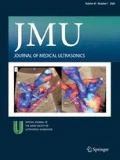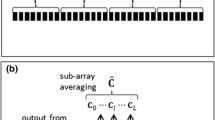Abstract
Purpose
Phased subarray imaging (PSA) was previously proposed to extend the receive aperture length. Using overlapped subarrays as transmitters in PSA leads to decrement of sidelobe levels of the overall beam compared to full phased array imaging (PHA). This paper proposes an adaptive compounding of subarray images in PSA to improve both the resolution and contrast compared with PHA.
Method
Adaptive apodization (ADAP) is defined proportional to the beamformed responses of subarrays such that the overall energy after compounding is minimized.
Results
The simulation and experimental results validate the performance of applying ADAP in PSA. The full width at half maximum (FWHM) at a depth of 30 mm in the proposed PSA is about 0.2 mm, compared to a FWHM of 0.6 mm with PHA imaging. Measuring the contrast ratio index shows that the ADAP method also improves the contrast in PSA imaging at least 25% compared to PHA imaging.
Conclusion
Applying the proposed ADAP, besides conventional compounding in PSA imaging, leads to improvement of both the resolution and contrast compared to PHA imaging.










Similar content being viewed by others
References
Ramm V, Smith SW. Beam steering with linear arrays. IEEE Trans Biomed Eng. 1983;30:438–52.
Christensen DA. Ultrasonic bioinstrumentation. New York: Wiley; 1988.
Frazer C, O’Brein WD. Synthetic aperture techniques with a virtual source element. IEEE Trans Ultrason Ferroelectr Freq Contr. 1998;45:196–206.
Bae MH, Jeong MK. A study of synthetic aperture imaging with virtual source elements in B-mode ultrasound imaging systems. IEEE Trans Ultrason Ferroelectr Freq Contr. 2000;47:1510–9.
Karaman M. Ultrasonic array imaging based on spatial interpolation. In: Proceedings of 3rd IEEE international conference on image processing. Lausanne: IEEE; 1996. p. 745–8. https://doi.org/10.1109/ICIP.1996.559606.
Johnson J A, Karaman M, Khuri Yakhub B T. Coherent array imaging using phased subarrays. Part I: basic principles. IEEE Trans Ultrason Ferroelectr Contr. 2005;52:37-51.
Johnson JA, Karaman M, Khuri Yakhub BT. Coherent array imaging using phased subarrays. Part II: basic principles. IEEE Trans Ultrason Ferroelectr Contr. 2005;52:51–64.
Karaman M, Wygant IO, et al. Mnimally redundant 2-D array design for 3-D medical ultrasound imaging. IEEE Trans Ultrason Ferroelectr Contr. 2009;28:1051–61.
Sadeghi M, Mahloojifar A. Improving beamforming performance by phased synthetic aperture imaging in medical ultrasound. J Med Ultrasonic. 2017;44:54–62.
Hwang JS, Song TK. A study of the display pixel-based focusing method in ultrasound imaging. Ultrason Imag. 2001;23:1–18.
Hassanien A, Vorobyov SA. Phased MIMO radar: a tradeoff between phased array and MIMO radars. IEEE Trans Signal Process. 2010;58:3137–51.
Sasso M, C Bacrie C. Medical imaging using the fully adaptive beamformer. In: Proceedings IEEE int conf acoust speech signal process. 2005; 2:489–92.
Synnevag JF, Austeng A, Holm S. Benefits of minimum-variance beamforming in medical ultrasound imaging. IEEE Trans on Ultrason Ferroelectr Freq Contr. 2009;56:1868–79.
Holfort LK, Gran F, Jensen JA. Broadband minimum variance beamforming for ultrasound imaging. IEEE Trans on Ultrason Ferroelectr Freq Contr. 2009;56:314–25.
Asl BM, Mahloojifar A. Contrast enhancement and robustness improvement of adaptive ultrasound imaging using forward-backward minimum variance beamforming. IEEE Trans Ultrason Ferroelect Freq Contr. 2011;58:858–67.
Asl BM, Mahloojifar A. A low-complexity adaptive beamformer for ultrasound imaging using structured covariance matrix. IEEE Trans Ultrason Ferroelect Freq Contr. 2012;59:660–7.
Nilsen CIC, Hafizovic I. Beamspace adaptive beamforming for ultrasound imaging. IEEE Trans Ultrason Ferroelect Freq Contr. 2009;56:2187–97.
Asen JP, Buskenes JI, Nilsen CIC, Austeng A, Holm S. Implementing Capon beamforming on a GPU for real-time cardiac ultrasound imaging. IEEE Trans Ultrason Ferroelect Freq Contr. 2014;61:76–85.
Park J, Wi SM, Lee JS. Computationally efficient adaptive beamformer for ultrasound imaging based on QR decomposition. IEEE Trans Ultrason Ferroelect Freq Contr. 2016;63:65.
Hasegawa H. Apodized adaptive beamformer. J Med Ultrasonics. 2017;44:155–65.
Jensen JA. Field: a program for simulating ultrasound systems. Proc Conf Biomed Imag. 1996;34:351–3.
O’Donnell M, Flax SW. Phase-aberration correction using signals from point reflectors and diffuse scatterers: measurements. IEEE Trans Ultrason Ferroelectr Freq Contr. 1988;35:768–74.
Silverstein SD. Ultrasound scattering model: 2D cross correlation and focusing criteria theory, simulations, and experiments. IEEE Trans Ultrason Ferroelec Freq Contr. 2001;48:1023–30.
Author information
Authors and Affiliations
Corresponding author
Ethics declarations
Conflict of interest
There is no conflict of interest.
Ethical considerations
This article does not contain any studies with human or animal subjects performed by any of the authors.
Additional information
Publisher's Note
Springer Nature remains neutral with regard to jurisdictional claims in published maps and institutional affiliations.
About this article
Cite this article
Sadeghi, M., Mahloojifar, A. A novel adaptive apodization to improve the resolution of phased subarray imaging in medical ultrasound. J Med Ultrasonics 47, 13–24 (2020). https://doi.org/10.1007/s10396-019-00970-2
Received:
Accepted:
Published:
Issue Date:
DOI: https://doi.org/10.1007/s10396-019-00970-2




